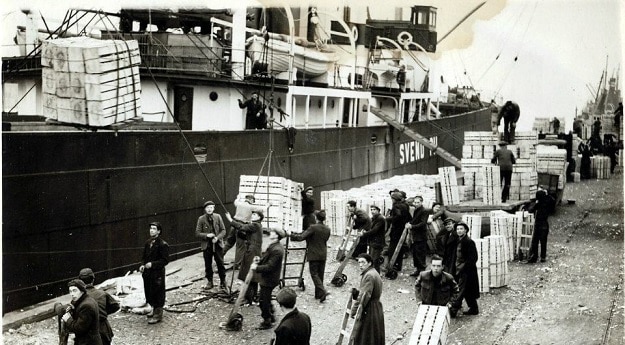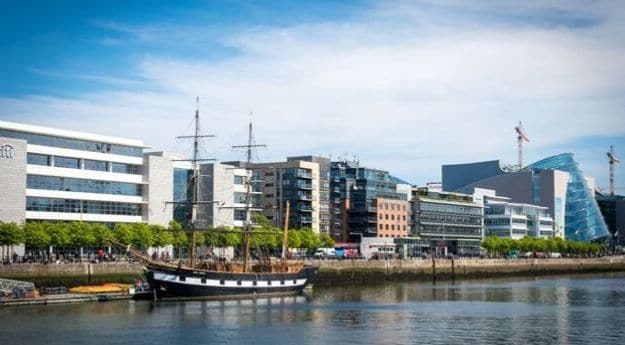The 1911 census shows that dockers’ wives and daughters most frequently worked as maids, housekeepers and domestic servants. Though some had roles as dressmakers, tailors and launderers too. However, according to Working Lives of Dublin’s Deep-Sea Port by Aileen O’Carroll and Don Bennett. One woman in the census was listed as a dock worker. 26-year-old Mary Plunkett gave her occupation as a ship winch driver. This would have been highly unusual at the time – and even in the decades that followed.
Lever Brothers Soap Factory
Right up until the 1950s, domestic work was the common employment among women. But throughout the 1930s, women’s employment in factories around the city grew.
In the Docklands, the likes of Lever Brothers on Sheriff Street, Boland’s Bakery in Ringsend and Mitchell’s Rosary Bead Factory on Waterford Street became well-known for employing local women.
During one of 14 Henrietta Street’s Teatime Talks, Declan Byrne of the Dublin Dock Workers Preservation Society remembers how the soap factory’s mainly female workforce was made up of locals from Sheriff Street, North Wall, East Wall, Pearse Street and Ringsend.
As he recalls it: “The women there were paid less than the men. So 95% of the workers were women on full rate and 5% were men as managers.” Other factories around the area had a similar structure.
However, women usually left these jobs once they got married. In fact, Lever Brothers would give their female staff a Westminster chime clock as both a wedding gift and their goodbye present, according to Working Lives of Dublin’s Deep-Sea Port.
The Dublin Dockyard War Munitions Factory
During World War I, the munitions factory on East Wall Road was set up to make 18-pounder shell casings. They would then go to mainland Britain to be filled with explosives before being sent to the battlefields of the Western Front.
At the time, munitions jobs were reserved for women because men were needed as soldiers. So between 1915 and 1918, The Dublin Dockyard War Munitions Factory hired around 200 women from the local area.
Their high-paying wages brought relief to many women and their families. Some of whom had endured great difficulties during the 1913 Dublin Lockout. According to Fionnuala Walsh of UCD, one woman named Florence Lea saw her weekly wage rise from six shillings to 50 shillings after she left a sewing factory to work at the munitions plant.
These high-earning women contributed to an upsurge in glamorous fashion and beauty products. Many of them also continued the strong trade union traditions of the dock worker by joining the National Federation of Women Workers.
Dublin Port Milling Company
In the 1960s, another woman landed a job as a dock worker in Dublin Port. In an interview with Ports, Past and Present, Kay Foran of Gardiner Street shared the story of how she joined the Dublin Port Milling Company.
Because she complained about the conditions in Dublin’s sewing factories, her father – who was a docker – told her to find a union job. She went to Liberty Hall to speak with a union official who knew her father, but he only had roles suitable for men.
At the age of 16, Foran argued that she could do the same work as a man. “It was coming into the 60s and I was getting notions,” she said in the interview.
So she went to the Dublin Port Milling Company, where women normally only worked in the bakery, and convinced the foreman to take her on in a position reserved for men.
Much to her father’s surprise, she landed a job in the male-dominated environment. “He had seen women on the docks,” she commented. “But they weren’t working where I was being sent.”
She distinctly remembers that the pay was £6.50 – considerably better than the £2.50 she had received at the sewing factory. For two years, she happily worked brushing up overflowing flour in the port’s silos. But she left when she got married.
Changing times
Despite pioneers like Mary Plunkett and Kay Foran, very few dock workers at Dublin Port were women. But this wasn’t the case in every country.
“We used to get cargo in from Russia and they said the women loaded it,” said Alan Martin of the Dublin Dock Workers Preservation Society.
In later years, Martin also recalls some women dock workers driving forklifts. But as technology reduced the manual demands of the job, making it more accessible to women. This also reduced the number of people needed to unload ships.
To find out more about the history of Dublin’s Docklands and the role it played in Irish emigration, visit the Jeanie Johnston tall ship. Book a tour here.
(Featured image: Dublin Dock Workers Preservation Society)


